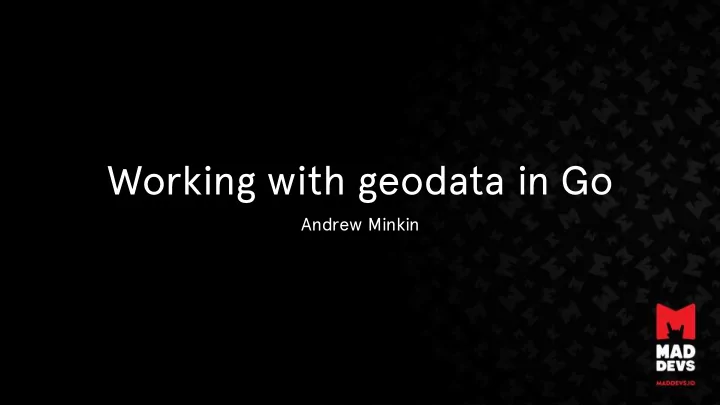

Working with geodata in Go Andrew Minkin
Who am I • TeamLead at maddevs.io • 10 years of experience • https:/ /github.com/meshbird/meshbird
Bishkek • 1kk citizens • 100++ taxi services
Namba Taxi • 8k orders • 600+ online drivers • 500k clients
What’s a taxi • Clients • Voice • Text • Mobile App • …. • Drivers • Operators • Managers
AVG response time • Drivers 20 ms • Operators 2.5 ms
Prehistory
First challenge • Decrease update interval on driver’s device • Interval 15 secs
First try • Make request -> save coordinates • Make request -> animate the car
First problems • We can’t animate car properly • Car moves through fields, forests and quarters
First problems
Solution • OSRM
Try again • Timeout – 15 secs • Make request -> save coordinates • Send coordinates • Building route via OSRM • Get route -> animate marker
Solution • Check for 20 meters
Application Released!
Needs improvement • Trip cost calculations on driver side • We need more tracks and 1 track at 15 seconds is few • GPS problems on driver
GPS problems • Bad device/Bad module • GPS going to die during the time • Pits and “Jams”
Tasks • Start to collect more tracks from drivers • Show animated cars on the main screen • Store intermediate trip cost on the server side • Save mobile data • Collect each track per one second
What’s the track? • Latitude • Longitude • Session • OrderID • TripCost
Trafic economy • 1 track = 100 bytes
Tell me all the options, please • HTTP • WebSockets • TCP • UDP
Tell me all the options, please • HTTP • WebSockets • TCP • UDP
Why we choosed UDP? • We send only datagrams • We don’t need guarantees • Minimalism • Save lots of data • We have only 20 bytes overhead • Not blocked in our country
What about data serialization? • JSON L • MsgPack L • Protocol Buffers J
Data size Protobuff 42 MsgPack 127 JSON 137
Total • 42 bytes of payload • + 20 bytes of IP headers • = 62 bytes per track • = PROFIT!
Data storage
What data to store? • Driver’s session • Cab number • Order ID • Trip cost • Last location • N last locations
Which storages do we use? • Percona • Redis • Elasticsearch
We need geoindex • KD-tree • R-tree
What requirements for geoindex • Search of N nearest points • Balanced tree
KD-Tree
KD-tree cons • Unbalanced tree • Can search only one nearest point
R-tree
Where can I get it? • https:/ /github.com/dhconnelly/rtreego
What’s wrong with drivers? • Bad internet connectivity • Turned off the phone • Low battery • Removed application from RAM • And lots of other reasons
• We need expire mechanism • We need LRU data structure for storing coordinates
Storage architecture • In-memory • R-tree • Map with drivers(key is the session) • Map with drivers(key is cab number)
What algorithm on backend • Get data by UDP • Try to get driver from storage • If doesn’t exist – get driver from redis • Check and validate data • Set driver to storage • If doesn’t exist – initialize LRU • Update r-tree
Go • Strong typed and compiled • Small size of docker containers • Few resource usage • Less own zoo J
HTTP API • Return nearest drivers • Remove driver from storage(by cab number or session) • Get information about trip • Get information about driver
How to maintain • Logging into stdout/stderr • Metrics to Graphite • Checks to sensu • Usefull /status • Bots
Usefull /status • Uptime since • HTTP Statuses counters • Total requests
Bots • Emulate of driver’s workflow • Emulate of client’s workflow • Running near Marokko or Congo
How it looks now? • We get client location from sensors • We get nearest drivers with routes • Animate each car • Update interval 15 seconds
Main slide of first story • UDP+Protobuf for data savings • In-memory storage • R-tree for nearest drivers • LRU cache for storing last locations • OSRM for map matching and building routes
Challenges in geocoding
What challenges do we have? • Lack of data • Crossroads navigation • We can’t trust GPS
Which map providers available? • Yandex • Google • 2GIS
What we have to solve issue • OpenStreetMap data • Own database with addresses with coordinates
Search format example • Chui ave 139 • Chui / Manasa • Red centre • AUCA • 5-15 • 7 marksa 181
We need own geocoder • Available to search in different formats • Support for auto translated values • Support of synonyms
Elasticsearch index • Addresses(alias) • OSM_timestamp • Drivers_data
./ariadna update • Download file • Create index in Elasticserach • Populate with data from osm • Search intersections and populate data • Change aliases • Removes old index
Features • Geocode • By the name • By crossroad • By the name of institution • Synonyms support • Reverse geocode
Where to get it? • https:/ /github.com/maddevsio/ariadna
Questions? • https:/ /github.com/maddevsio • https:/ /github.com/maddevsio/ariadna • @gen1us2k (twitter,github,facebook,skype,telegram)
Recommend
More recommend